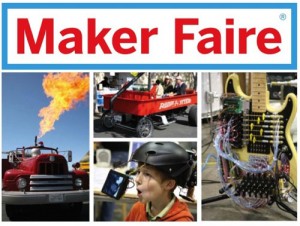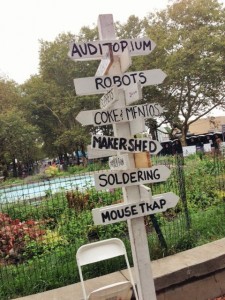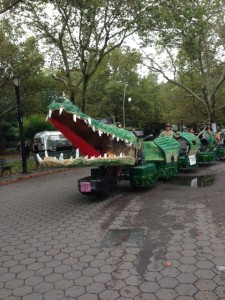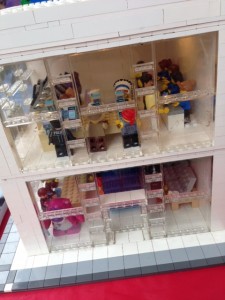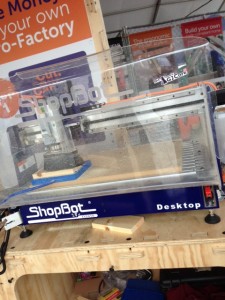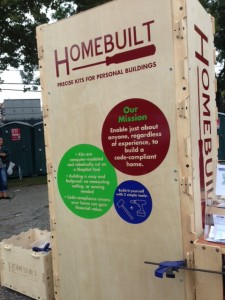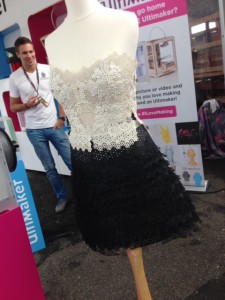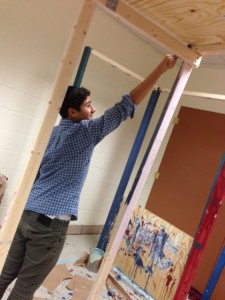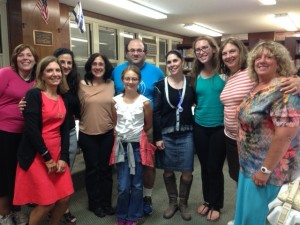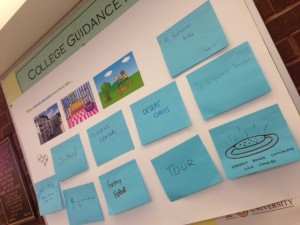September 21 saw a group of Jewish educators — and students — attend the NYC Maker Faire. For those of you who aren’t familiar with the Maker Movement, here’s a good definition from techopedia.com:
Definition - What does Maker Movement mean?
The maker movement is a trend in which individuals or groups of individuals create and market products that are recreated and assembled using unused, discarded or broken electronic, plastic, silicon or virtually any raw material and/or product from a computer-related device.
The maker movement has led to the creation of a number of technology products and solutions by typical individuals working without supportive infrastructure. This is facilitated by the increasing amount of information available to individuals and the decreasing cost of electronic components.
Techopedia explains Maker Movement
The maker movement is primarily the name given to the increasing number of people employing do-it-yourself (DIY) and do-it-with-others ( DIWO) techniques and processes to develop unique technology products. Generally, DIY and DIWO enables individuals to create sophisticated devices and gadgets, such as printers, robotics and electronic devices, using diagrammed, textual and or video demonstration. With all the resources now available over the Internet, virtually anyone can create simple devices, which in some cases are widely adopted by users. For example, MintyBoost, a popular DIY USB charger kit built using an Altoids tin, batteries and a few connectors, can easily be created using instructions online, or purchased from other makers who sell their devices.
Most of the products created under the maker movement are open source, as anyone can access and create them using available documentation and manuals.
However, the maker movement also incorporates creations and inventions that never existed before and were developed by individuals in their homes, garages or a place with limited manufacturing resources.
DIY, STEM, and PBL
Since Project-Based Learning (PBL) emphasizes student interests and passions and because Science, Technology, Engineering, and Math (STEM) is such a focus in schools now, it’s no wonder that the do-it-yourself joy of making is seeping into schools.
A lot of times. though, we’ve seen the rush in education to play with the latest gadget (OK, pun slightly intended) without an initial, thoughtfully laid-out plan about how to use our new toys. Of course, at the very essence of the Maker Movement is a kind of spontaneous tinkering, but because class time is so precious, educators want to know how the Maker Movement contributes to a school’s — and in the case of Jewish education — to a Jewish school’s primary goals and concerns.
Jewish educators who attended the Maker Faire asked themselves just those questions, but it wasn’t just Jewish educators who got to voice their opinions. Students as well contributed to the discussion:

I had a great time at the Maker Faire with Oren Mendelow, video and tech whiz of Kushner Academy; Ari Mendelow, a Rutger’s engineering student; and Ronit Langer, a Frisch School senior interested in a career in STEM. Amitai Cohen, another Frisch senior who has been a techie for years, joined us later in the day
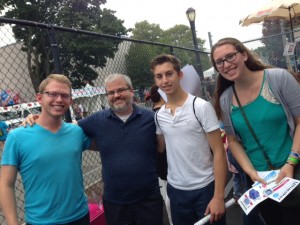
We bumped into Rabbi Tzvi Pittinsky (@TechRav), Frisch’s Director of Educational Technology, at the Maker Faire!
What Did We See?
What exactly happens at a Maker Faire? Well, you get to see a lot of cool gadgetry; think Inspector Gadget meets LEGO meets 3-D printing meets the Green Movement:
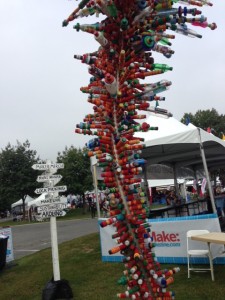
This eco-friendly sculpture is made from recycled plastic bottles and bottlecaps and is something Mrs. Ahuva Mantell, Frisch’s art teacher who attended the Maker Faire and who runs the school’s Environmental Club, no doubt enjoyed seeing
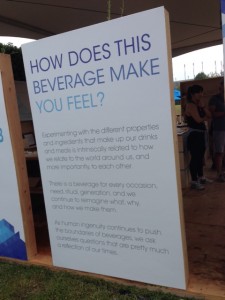
The bottle sculpture was next to a stand discussing the drink of the future, a mood-altering beverage that sounded as if it were something right out of The Jetsons — or Brave New World
Other highlights from the Maker Faire were 3-D printing demos — here, there, and everywhere — , arduino boards and Raspberry Pis up the wazoo, lifestyle cars, and all things LEGO. Check out this Apple store made out of the legendary building blocks. The “store” was next to a booth about E-nabling the Future, a network that uses cheap 3-D printing materials to create prosthetics for children who cannot afford expensive ones. Especially because children are always growing, they need prosthetics they can easily replace.
One of the things that’s fun about the Maker Faire is the juxtaposition of the very serious and socially responsible with the whimsical and weird. In fact, here are some products that would enable both, wood shop “printers” and home builders:

You don’t need serious tools or expensive shop-bots to build, though. Simply take apart old electronic devices and see what you can create. Mrs. Mantell taught me that a couple of years ago; she’s been re-purposing all sorts of materials for years!
Another thing I liked about the Maker Faire was the opportunity it offered girls interested in STEM. From 3-D printed dolls and dresses to wearable technologies that caused clothing to change color when the weather altered, the displays and demonstrations showed me, Ronit Langer, and Magen David faculty member Naomi Weiss what was possible for girls who had gender-traditional interests as well as a technological bent:
Post-Maker Faire Party
After the Maker Faire, Ronit Langer, Naomi Weiss, and I headed to the Solomon Schechter School of Queens, which hosted dinner for anyone interested in discussing what we had seen during the day. Thanks to Head of School Shira Leibowitz and Director of Educational Technology Rebecca Penina Simon for helping me plan the event and for graciously letting us have it at SSSQ. Rebecca is running the school’s Maker Space, so I was especially eager to hear what she had taken away from the day. We were joined by Janine Lalander, SSSQ lower school Science teacher, Yavneh Academy’s Director of Technology Chani Lichtiger,Technology Coach Claire Hirschhorn, and fifth-grade teacher Sharon Sherman, as well as Montessori School advocate Daniel Petter-Lipstein and his daughter Liora.
Over a delicious dinner from Carlos and Gabby’s, we discussed:
Where to fit a Maker Space into a curriculum:
Rebecca and Shira shared how they did it: they created 8th-grade electives, and those students interested in Making signed up for Rebecca’s class. Rebecca used her Twitter PLN and training and guidance from Maker State to prepare for the course, which you can read more about in her informative and exciting blog post.
SSSQ’s Maker Space is filled with self-selected students, so we also asked ourselves what we might gain from introducing all kids to Making at a young age, giving them exposure to it in the same way we give them exposure to the arts and a wide range of disciplines.
Why have a Maker Space:
Though a Maker Space is obviously a great way to teach students STEM, we all concluded that an equally important by-product of Making is that it produces joyful, active learning and promotes creativity. It also shows students that they can have a self-generated idea that they can bring to fruition.
In addition, our group discussed the pro’s and con’s of keeping a Maker Space separate from course curriculum, keeping Making in its own discrete space, or, alternatively, combining it with course content. What if students were to learn about dinosaur fossils and then have to 3-D print them? Or study urban design and then light up a model city?
Or how would Magen David Talmud teacher Rabbi Joseph Esses — who also attended the Maker Faire — change his Sukkah-building project if he had ShopBot?
Though we didn’t come to any set conclusions over our meal, we all agreed that the Maker Movement was something we wanted our students to be a part of, and we left feeling committed not only to ensuring that happened but to helping each other along the way.








